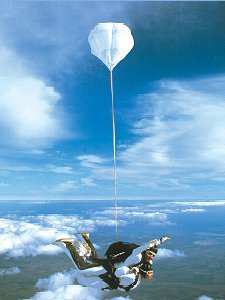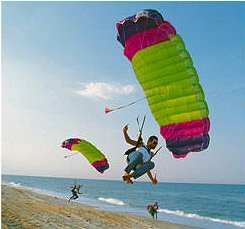An ANN Special Report: Since When Is The FAA Using the Media to
Do Its Dirtywork?
(Part Two of a Four Part Special Report)
 One of the amazing lessons of the
last few years is that fewer and fewer skydivers are dying because
their rigs don't open before impact. The new generation of high
performance ram-air canopies perform extraordinarily well... though
there are some that perform quite mildly, and some that perform
quite aggressively (i.e., along the lines of the differences one
might find between a Cessna 150 and a Pitts Special). Those
aggressive canopies are now being blamed for nearly half the fatal
accidents that befall skydivers each year, as their failure to
learn to properly pilot their canopies results in high speed
descents that often end in catastrophic impact.
One of the amazing lessons of the
last few years is that fewer and fewer skydivers are dying because
their rigs don't open before impact. The new generation of high
performance ram-air canopies perform extraordinarily well... though
there are some that perform quite mildly, and some that perform
quite aggressively (i.e., along the lines of the differences one
might find between a Cessna 150 and a Pitts Special). Those
aggressive canopies are now being blamed for nearly half the fatal
accidents that befall skydivers each year, as their failure to
learn to properly pilot their canopies results in high speed
descents that often end in catastrophic impact.
Since most of those who buy and operate such canopies are
experienced jumpers (with that kind of performance, you almost have
to be), properly licensed and with the proper privileges
established before-hand, it is their right to try more and more
aggressively featured canopies to derive the kind of performance
they ultimately seek. In other words, a licensed jumper has the
right to choose a high performance canopy and the DZ they jump from
has little to say in the matter.
 Kapowsin, was the location, though,
for a horrific and notable tragedy in which two student/instructor
teams were involved in fatal accidents over the course of just two
days. The tragic coincidence involved "Tandem" skydive instruction
in which a licensed Tandem Instructor is attached to a student, who
then freefall and deploy a parachute as a single unit. That way,
the skill and knowledge of the instructor is literally inches away
from the student at all times. Some times, though, that isn't
always enough. Fate can be tricky.
Kapowsin, was the location, though,
for a horrific and notable tragedy in which two student/instructor
teams were involved in fatal accidents over the course of just two
days. The tragic coincidence involved "Tandem" skydive instruction
in which a licensed Tandem Instructor is attached to a student, who
then freefall and deploy a parachute as a single unit. That way,
the skill and knowledge of the instructor is literally inches away
from the student at all times. Some times, though, that isn't
always enough. Fate can be tricky.
The pair of documented accidents occurred when the student in
the first fatal tandem team "reached up unexpectedly and pulled the
emergency canopy release handle before the tandem master could stop
her." A mysterious deployment of the reserve resulted in a spinning
canopy and the death of the instructor. That accident was deemed
the result of an "unpreventable" student action. Such an accident
can be likened to a student who pulls the mixture in the air
instead of the carburetor heat... it happens so fast, and
unexpectedly, that without sufficient time to correct the action,
the results are often insurmountable. The other accident was even
more strange... While on approach for landing, a student/instructor
tandem team was hit by what was described as a violent bit of
low-altitude wind shear. What ensued was a rare, partial canopy
collapse that greatly increased their rate of descent. They were so
low when the wind shear hit, they didn't have time to initiate a
recovery before impact. The student was killed in that
accident.
The Kyle Robinson Accident
 One of the cornerstones of the
Kapowsin story was Halsne's heart-rending tale, of Kyle Robinson...
a jumper who died some eight years previously. The tale was
emotionally rendered by Robinson's father. Claiming that Kapowsin's
death rate was "four times the national average," Halsne told an
alarming story of a drop zone that appeared to have no concern for
the safety of its jumpers, aircraft or those in the surrounding
area. At first look, it's a hell of an alarming story... the kind
that makes you sit up and take notice. It would have been, if the
story had been portrayed accurately. In conversations with ANN, the
USPA says Kapowsin's operation was looked over "thoroughly" after
that deadly weekend and found to have not been at fault in either
accident. That fact was omitted from Halsne's story on KIRO.
One of the cornerstones of the
Kapowsin story was Halsne's heart-rending tale, of Kyle Robinson...
a jumper who died some eight years previously. The tale was
emotionally rendered by Robinson's father. Claiming that Kapowsin's
death rate was "four times the national average," Halsne told an
alarming story of a drop zone that appeared to have no concern for
the safety of its jumpers, aircraft or those in the surrounding
area. At first look, it's a hell of an alarming story... the kind
that makes you sit up and take notice. It would have been, if the
story had been portrayed accurately. In conversations with ANN, the
USPA says Kapowsin's operation was looked over "thoroughly" after
that deadly weekend and found to have not been at fault in either
accident. That fact was omitted from Halsne's story on KIRO.
Kyle Robinson was an experienced skydiver with upwards of 500
jumps under his belt. He died after trying out a new,
high-performance canopy. Robinson was jumping a new canopy called a
Stiletto 135... and he had only jumped it a few times before his
death. Somehow, he managed to impair its normal operating
configuration so low to the ground that the recovery was simply not
possible before impact.
While Robinson was an experienced/licensed jumper, that canopy
was quite new to him. In fact, the canopy was fully open and
deployed before the accident that claimed his life. According to
published witness reports, Robinson did a hard turn at 300 feet
that was so fast as to induce line twists in the suspension lines
between his canopy and harness. Such line twists not only make it
difficult to control the canopy, but may induce a turning moment if
the line twists are not symmetrically incurred. The result was a
short, steep spiral (with the canopy still partially collapsed)
that the reportedly 200+ pound Robinson was unable to arrest before
impacting on his side at a speed estimated to be about 35 mph.
Journalist Mark Harju, a contributor to Skydiving magazine, sums
up the incident succinctly, "Despite being warned not to, Kyle
Robinson knowingly risked flying a small canopy with a reputation
for being difficult and dangerous to handle. He lost control of it
and died in a bad landing. To imply that Kapowsin Air Sports or the
Farrington family is somehow to blame for Robinson's death is
irresponsible."
 One must note that the story quotes
Kyle's father, Bill Robinson, as saying that he "welcomes a federal
safety investigation." The fact is that the way skydiving
intersects with flying is largely regulated under FAR Part 105.
However; the majority of the regulatory responsibility thrust upon
the skydiving community is borne by the US Parachute Association...
who has an extensive system of licensing, instruction, inspections
and oversight that has had a strong impact (no pun intended) on the
accident rate of the sport parachuting community... a continually
improving accident rate that is far less than it was in year's
past. USPA does provide oversight and investigation into sport
parachuting accidents... including that which claimed the life of
Kyle Robinson. USPA's expertise is recognized and called upon by
the FAA and NTSB as warranted, in it's investigations of skydiving
matters. USPA found no fault with Kapowsin, its staff, or its
operations, and pretty much indicated that the Robinson accident
was a situation in which Robinson's errors contributed to his own
demise.
One must note that the story quotes
Kyle's father, Bill Robinson, as saying that he "welcomes a federal
safety investigation." The fact is that the way skydiving
intersects with flying is largely regulated under FAR Part 105.
However; the majority of the regulatory responsibility thrust upon
the skydiving community is borne by the US Parachute Association...
who has an extensive system of licensing, instruction, inspections
and oversight that has had a strong impact (no pun intended) on the
accident rate of the sport parachuting community... a continually
improving accident rate that is far less than it was in year's
past. USPA does provide oversight and investigation into sport
parachuting accidents... including that which claimed the life of
Kyle Robinson. USPA's expertise is recognized and called upon by
the FAA and NTSB as warranted, in it's investigations of skydiving
matters. USPA found no fault with Kapowsin, its staff, or its
operations, and pretty much indicated that the Robinson accident
was a situation in which Robinson's errors contributed to his own
demise.
To be continued...
 ANN's Daily Aero-Linx (12.03.25)
ANN's Daily Aero-Linx (12.03.25) ANN's Daily Aero-Term (12.03.25): CrewMember (UAS)
ANN's Daily Aero-Term (12.03.25): CrewMember (UAS) NTSB Prelim: Maule M-7-235A
NTSB Prelim: Maule M-7-235A Airborne-Flight Training 12.04.25: Ldg Fee Danger, Av Mental Health, PC-7 MKX
Airborne-Flight Training 12.04.25: Ldg Fee Danger, Av Mental Health, PC-7 MKX Aero-News: Quote of the Day (12.04.25)
Aero-News: Quote of the Day (12.04.25)





